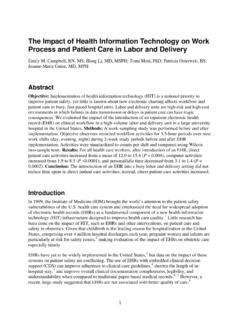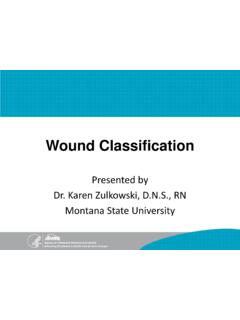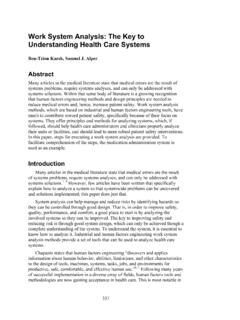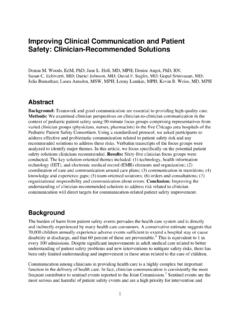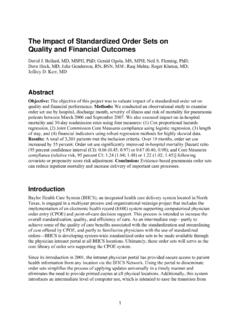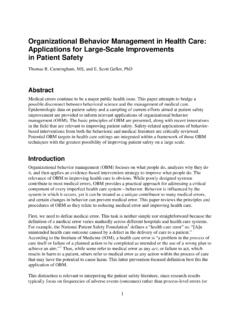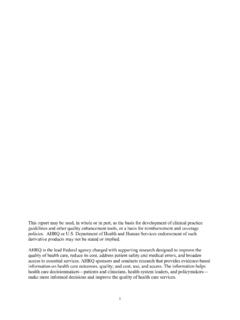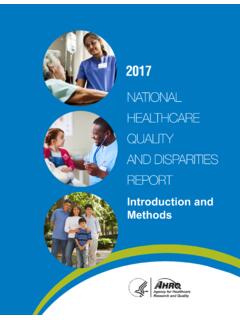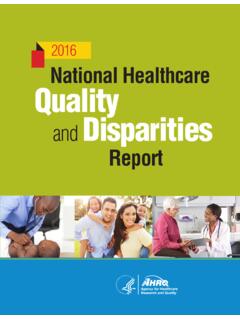Transcription of Tools for Reducing Central Line-Associated Blood Stream ...
1 Tools for Reducin g Central Line-Associated Bl ood Stream infections January 2013 1 Table of Contents Purpose of the Tools .. 2 Engage: How does this make the world a better place? .. 2 Educate: How will we accomplish this? .. 3 Execute: What do I need to do? .. 5 Evaluate: How will we know that we made a difference? .. 8 References .. 10 Appendixes Appendix 1. Weeks Without CLABSIs Banner Appendix 2. Central line associated bloodstream infections Fact Sheet Appendix 3. Vascular Access Device Training Slides Appendix 4. line Cart Inventory Appendix 5. Central line Insertion Checklist Appendix 6.
2 Central line Maintenance Audit Form Appendix 7. CLABSI Event Report Template Appendix 8. CLABSI Investigation Nurse Letter Appendix 9. Back to Basics document 2 Purpose of the Tools These Tools are designed to support your efforts to implement evidence-based practices and eliminate Central Line-Associated Blood Stream infections (CLABSI) in your unit. When used with the Comprehensive Unit-based Safety Program (CUSP) Toolkit, the Tools have nearly eliminated CLABSI in more than 100 participating Michigan intensive care units (ICUs)1 and have dramatically reduced CLABSI in more than 1,000 hospitals across the country in an AHRQ-funded initiative.
3 The Tools align with the E s found in the CUSP toolkit: 1. Engage: How will this make the world a better place? 2. Educate: How will we accomplish this? 3. Execute: What do I need to do? 4. Evaluate: How will we know we made a difference? Engage: How does this make the world a better place? CLABSI is associated with significant morbidity, mortality, and ,3 Patients in ICUs are at an increased risk for CLABSI because 48 percent of ICU patients have indwelling Central venous catheters, accounting for 15 million Central line days per year in Assuming an average CLABSI rate of per 1,000 catheter days and an attributable mortality of 18 percent (0-35 percent), as many as 28,000 patients die from CLABSI annually in ,4,5 Efforts to decrease the rate of CLABSI and improve the quality of care are paramount.
4 To engage your colleagues, first make the CLABSI problem real by identifying a patient on your unit who suffered needless harm from a CLABSI and share that patient s story with your colleagues. Once you share the story with your colleagues and leaders, ask them if this is the kind of care they would want for their family, if this is care they are proud of, and if this is the best your unit can do. Second, post the number, by month, of patients who developed a CLABSI and the total number of CLABSI cases for the previous year on your unit. Post a trend line so nurses and physicians can see at a glance the unit s CLABSI rate and how it changes over time.
5 Post the number of days (or weeks or months) since the unit s last CLABSI. (A banner that shows the number of weeks without a CLABSI is provided at Appendix 1.) Use formal and informal opportunities to talk about the intervention and about unit-specific infection rates. Third, raise awareness among unit staff members of evidence-based practices to eliminate CLABSI. The biggest barrier to compliance with evidence-based practice is that providers do not know the evidence exists or do not know what they should be doing. To inform providers, give them the Central line associated bloodstream infections Fact Sheet at Appendix 2 that outlines evidence-based practices to eliminate CLABSI and gives supporting evidence for each practice.
6 Once a week for two consecutive weeks, determine the number of staff members 3 who received the fact sheet. If fewer than 90 percent of staff members received it, hold a meeting to increase knowledge of evidence-based practices among providers. Fourth, using baseline data on CLABSI rates on your unit, calculate the potential opportunity to improve the number of preventable CLABSIs, preventable deaths, excess hospital days, and cost savings per year. Make a point of recognizing providers who appropriately follow evidence-based practices. Invite your hospital infection control professional or epidemiologist to become an active part of your unit s CUSP team and draw on their expertise to help with your specific challenges.
7 The goal should be that no patient suffers harm from a preventable complication while on your unit. Finally, make sure your staff members recognize that benchmarking your performance against similar units and striving for the 50th percentile is unacceptable for preventable complications. Your unit s goal should be that no patient suffers harm from a preventable complication while under your care. You can eliminate infections , and any infection should be viewed as a defect. Educate: How will we accomplish this? Make sure your staff members understand how they can reduce CLABSI. Numerous interventions have reduced the incidence of CLABSI and the ensuing morbidity, mortality, and 9 In addition, the Centers for Disease Control (CDC), the Society of Critical Care Medicine, the Society of Healthcare Epidemiologists of America (SHEA), the Infectious Disease Society of America (IDSA), and several other organizations have developed evidence-graded guidelines to prevent catheter-related Several of the guideline recommendations are supported by clinical trials or systematic reviews.
8 Interventions to eliminate CLABSI include-- Appropriate use of hand hygiene Chlorhexidine skin preparation Full-barrier precautions during Central venous catheter insertion Avoiding the femoral site when possible Maintaining a sterile field while inserting the line2 Improving compliance with these evidence-based practices will result in dramatic reductions in CLABSI rates on your unit. Additionally, partnering with the hospital epidemiologist or an infection control practitioner can help your CUSP team-- 1. Ensure you are using National Healthcare Safety Network definitions for CLABSI11,12 2. Educate staff members about how to reduce CLABSI 3.
9 Ensure you have chlorhexidine in your Central line kits 4. Post publicly the number of people infected per month and your quarterly infection rates 4 Using baseline data on CLABSI rates on your unit, you can also calculate the number of preventable CLABSIs, preventable deaths, excess hospital days, and costs per year. Also provided in this toolkit are Vascular Access Device Training Slides (Appendix 3) that you can use to educate staff. Consider holding staff in-service sessions to review those PowerPoint slides and the Fact Sheet (Appendix 2) and provide answers to staff members questions. Consider using a quiz to test the providers knowledge after the in-service and requiring providers to pass the quiz prior to being allowed to insert Central lines on your unit.
10 You can also use the training slides to build CLABSI prevention training into physician and nurse orientation in your facility. An important component of staff education is process standardization. A potential barrier to compliance with evidence-based practices is that clinicians have to go to several different places to collect the equipment they need to comply with guidelines. Establishing well-stocked line insertion carts that contain all the equipment and supplies needed to insert Central lines reduces workflow complexity and makes it easy for clinicians to adhere to evidence-based practice. Gain consensus on what supplies should be included and how the Central line cart should be organized for your unit.

